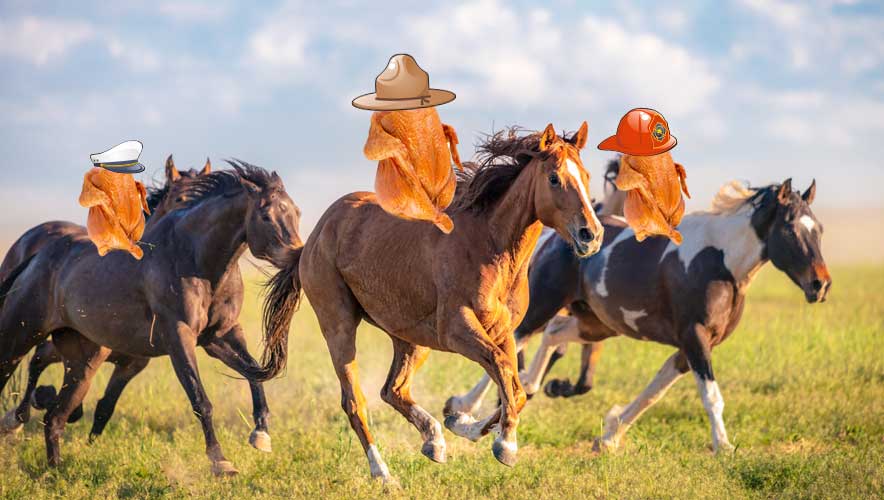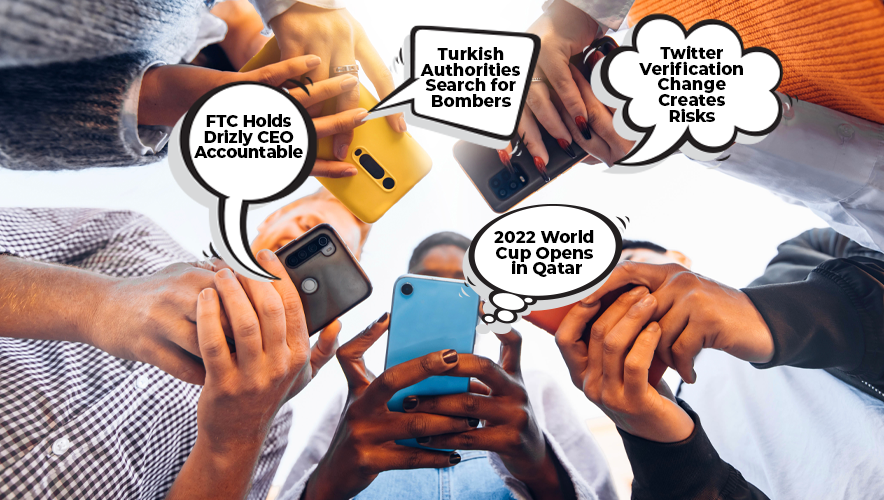Nine Security Social Media Accounts that are Making a Mark
Air fryer fans. Cat lovers. Motorcycle nerds. Space geeks. Travel enthusiasts. Good news aficionados. Bad map masters. Social media is full of communities that are passionate about whatever topic you’re most interested in.
With so many options (a few million on TikTok, Twitter, and YouTube, to name a few), sometimes the most difficult part of joining a social media community is figuring out where you fit in, who you want to be connected to, and how to share your message effectively.
When it comes to security awareness, a little humor goes a long way. Security Management collected a list of some of our favorite security social media accounts and movements that are hitting the mark and inspiring new energy in the industry.
Government Gurus: Rob Joyce and Jen Easterly on Twitter
They’re from the government. And they’re here to help, or at least that’s what the memes say.
Sometimes incident response feels like: pic.twitter.com/05j5DYxbGv
— Rob Joyce (@NSA_CSDirector) October 28, 2022
The National Security Agency (NSA) Cybersecurity Directorate is tasked with preventing and eradicating cyber threats to the U.S. Department of Defense, National Security Systems, and the Defense Industrial Base. It’s a serious role. But sometimes to get your point across, you need to use a bit of humor.
Enter, Rob Joyce on social media. Joyce is the director of the NSA Cybersecurity Directorate, a regular speaker at security industry events, and a frequent Twitter user, promoting cybersecurity best practices, posting new threat information, poking fun at vendors, and sharing memes about the chaotic, challenging, and—sometimes—fun daily life of cybersecurity practitioners. Find Joyce on Twitter: @NSA_CSDirector.
On the other side of the cybersecurity house, the U.S. Cybersecurity Infrastructure Security Agency (CISA)—part of the U.S. Department of Homeland Security—works to enhance the security, resiliency, and reliability of America’s cybersecurity and communications infrastructure. A key part of this is working with private sector partners, who in many instances own or operate the critical infrastructure the country relies on.
To help foster these connections, CISA Director Jen Easterly uses Twitter to build a community and create connections between the private and public sectors. You’ll see updates from Easterly on events, CISA’s work with partners to enhance security across critical infrastructure, and lots of Rubik’s Cube, rock music, and 1980s references. Find Easterly on Twitter: @CISAJen.
When it comes to MFA adoption, it’s time for radical transparency. We're urging business leaders & technology vendors to share their MFA adoption stats, to regularly nudge end-users to adopt MFA, & ultimately move towards FIDO adoption: https://t.co/v8BLwPj9X8 #MoreThanAPassword pic.twitter.com/wQ054SUfKx
— Jen🛡Easterly (@CISAJen) October 18, 2022
Meet Up with malwaretech
You might not know malwaretech, aka Marcus Hutchins, but you’re probably familiar with his work—specifically how he helped stop the WannaCry ransomware attack from spreading in May 2017.
Since then, he’s continued his work to teach others about cybersecurity. He has a blog, but he has also embraced using social media to share his content and connect with new audiences—including on TikTok. He shares videos breaking down hacker scenes in movies and televisions shows (like Stranger Things), updates on recent breach tactics, and general information about how to avoid being scammed online, such as in the video below where he walks viewers through how a common USPS scam works. Find him on TikTok: @malwaretech. Or, you can watch his videos on YouTube: Marcus Hutchins.
@malwaretech Investigating a common SMS phishing scam pretending to be USPS #safety #security #scam ♬ original sound - Marcus Hutchins
Travel Tales with TSA
Going new places, meeting new people, and having new experiences is fun. But often moving between two places via plane is not. You have to be somewhere on time, present proper documentation, and then follow an ever-changing set of rules to enter the secure area of the crowded airport and eventually step on to your flight. It’s a lot to keep track of, which is where the U.S. Transportation Security Administration (TSA) Instagram account steps in to help.
View this post on Instagram
It shares tips on how to soar through your weekend travel plans, along with updates on what items are prohibited on flights, how to safely pack your snack stash, and more. Find the administration on Instagram: TSA. And check out our Q&A with one of their social media leads.
Hi, Helen
Everyone needs that person in their life who can provide life advice while simultaneously making you laugh so you’re actually inclined to remember it—and act on it.
Observe the CISO, trying to get the attention of the c-suite as to the emerging cyber threat. Also, how CISOs behave at cons… https://t.co/9fOSvawXBn
— Helen Patton (@CisoHelen) October 23, 2022
Helen Patton, a CISO for the Security Business Group at Cisco, takes on that role with her approach to Twitter. Prior to her current role, Patton was the CISO for The Ohio State University, and her passion for learning and advocating for the next generation of security practitioners is evident in her Twitter feed that is full of links to her latest security quandaries, recognition for her team, and collaboration efforts with the university community.
Find her on Twitter (@CISOHelen) or on Mastodon (@[email protected]).
BMWs, Brakes, and Bollards
Originally used to moor ships, bollards are now one of the most recognizable physical security measures in place around the world. Sometimes, they’re constructed out of cannons. Other times they appear in the form of large planters outside a building. Occasionally, they even move up and down.
We 💛 this song.#WorldBollardAssociation
— World Bollard Association™ (@WorldBollard) October 20, 2022
pic.twitter.com/HtBgTQXYih
There’s a wide range of options when it comes to bollards, and nearly all of them are effective in preventing vehicles—whether intentionally or not—from moving into an area they’re not supposed to enter. To showcase these features in action, the World Bollard Association (a parody account) shares images it collects and that others share of bollards around the world stopping cars, delighting dogs, and occasionally causing mayhem. Find them on Twitter: @WorldBollard.
Meet Bertie. Bertie loves bollards.#WorldBollardAssociation
— World Bollard Association™ (@WorldBollard) October 20, 2022
📸@BertieLakeland pic.twitter.com/97zhDowaiz
Sharing is Caring
How do you create a more diverse community and address systemic racism in cybersecurity? There are a lot of efforts underway, but one continuing movement on social media is #ShareTheMicinCyber.
Created by Camille Stewart Gloster, deputy national cyber director for technology and ecosystem for the White House, and Lauren Zabierek, executive director of the Cyber Project at the Harvard Kennedy School’s Belfer Center, #ShareTheMicinCyber is a social media campaign that “highlights the experiences of Black practitioners in this field, catalyzes a critical conversation on race in the industry, and shines a light on Black practitioners’ accomplishments to showcase them as experts in their fields all while creating professional opportunities and bringing the cyber community together,” according to its fact sheet.
So excited about this launch! I am proud of @ChanBGC @lzxdc @peterwsinger @divinetechygirl brining the vision to life! I look forward to watching the progress unfold and cheering you all on!
— Camille Stewart Gloster (@CamilleEsq) November 15, 2022
A big congratulations to the inaugural class of #ShareTheMicInCyber Fellows! 👏🏾👏🏾👏🏾 https://t.co/W4IvXHMPc1
The movement focuses on engaging Black cyber practitioners, cyber allies, and organizations, often pairing individual cyber allies with Black cyber practitioners to share their professional journey and expertise on the cyber allies’ social media platforms (Twitter and LinkedIn). To learn more about joining the movement, visit #ShareTheMicinCyber’s website or find it on Twitter: @ShareInCyber.
Testing the Limits
Do the locks on that door actually work? What about the security protocols in place to alert you when they don’t?
Asking these questions and filming their prospective answers is something Deviant Ollam has been doing for years. Ollam is a physical penetration specialist and founding partner/director of education at The CORE Group who also sat on the board of directors for the U.S. division of TOOOL—The Open Organization of Lockpickers—for 14 years.
Ollam’s YouTube account is full of videos on lockpicking, physical security consulting tactics, and travel security tips—from best practices for traveling with a firearm to securing your hotel room door. Watch all of them on Ollam’s channel: Deviant Ollam.
Safety Second
Did you know that more than 3 million people were injured by lawn or gardening equipment in the past decade? Or that nearly 50,000 people go to the emergency room each year in the United States because of carbon monoxide poisoning?
Probably not. Many of the most common safety hazards are, unfortunately, not top of mind for most people until the worst happens. This is where the U.S. Consumer Product Safety Commission’s Twitter profile comes into play. Each day, the CPSC uses memes and a cast of recurring characters to highlight concerns and share advice on how to protect yourself and those around you from everyday safety hazards—like unwatered Christmas trees.
Soon. pic.twitter.com/htZrl7Lm53
— US Consumer Product Safety Commission (@USCPSC) November 12, 2022
Find it on Twitter (@USCPSC) and read our interview with Joseph Galbo, social media specialist at CPSC, about using humor to share important security information that garners engagement.
Megan Gates is senior editor at Security Management. Connect with her at [email protected] or on LinkedIn. Follow her on Twitter: @mgngates.








